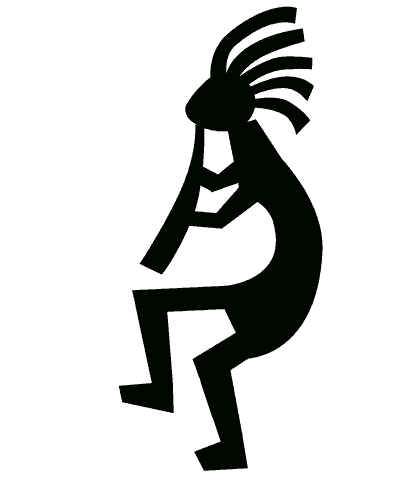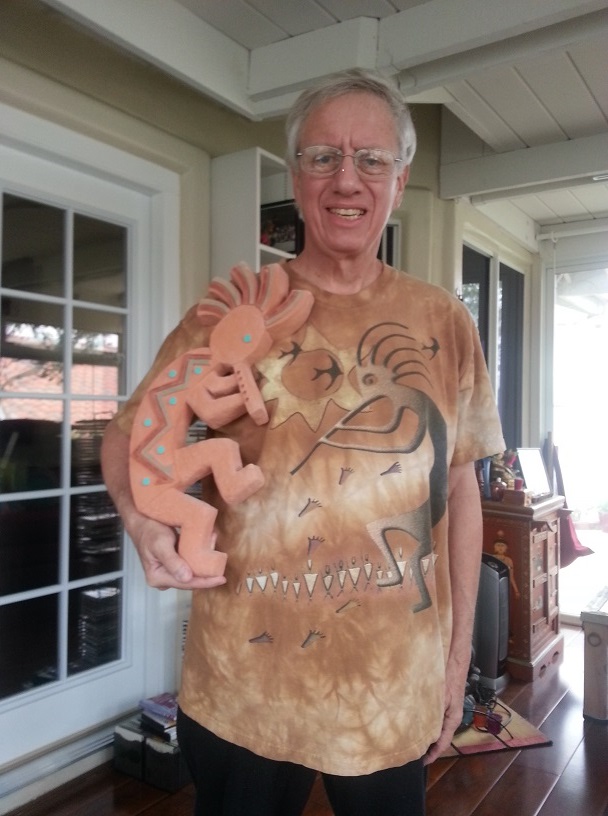Writers who, like me, work in genres such as horror and fantasy often mine the rich folklore, myths, and legends of different countries, cultures, ethnic groups and so on to enrich our stories. I thought it might be fun to explore some of the individual entities drawn from these resources, and so I am introducing a new, occasional feature to this blog. And what better character to open this series with than Kokopelli, the “Casanova of the Cliff Dwellers”?
Perhaps the most recognizable symbol in all of Native America, and an icon for the indigenous people of the American Southwest, Kokopelli has been around for thousands of years. Also known as the Humpbacked Flute Player, Kokopelli is a  Hopi fertility deity. He is also a trickster, a trader, a healer, a rainmaker, and a storyteller. On occasion he is depicted with a wife or consort named Kokopelli Mana, though she is far less known than her illustrious mate. His name might have been derived from the Zuni words for “god” (Koko) and “desert robber fly” (pelli). Regarding the latter, some of the earliest images of Kokopelli on cave paintings has him appearing more like an insect.
Hopi fertility deity. He is also a trickster, a trader, a healer, a rainmaker, and a storyteller. On occasion he is depicted with a wife or consort named Kokopelli Mana, though she is far less known than her illustrious mate. His name might have been derived from the Zuni words for “god” (Koko) and “desert robber fly” (pelli). Regarding the latter, some of the earliest images of Kokopelli on cave paintings has him appearing more like an insect.
Some say that the hump on Kokopelli’s back is actually a bag in which he carries things, and there are many thoughts on what those contents might be. Perhaps seeds, or songs to accompany his flute playing, or healing medicine, or shells and beads. But first and foremost Kokopelli was a fertility god, and the legends say that he carried babies in his sack to distribute to all of the young women that he seduced. It is said that he would arrive in a village one night, and when he departed the next morning, every one of the village’s maidens would be left with a kid. I’m talking a serious stud here! To support this, many early pictographs showed Kokopelli with an enormous penis. You don’t see much of that anymore, because when the Spanish priests came here to Christianize the indigenous people they “persuaded” them to lose the phallus in the name of decency. Hmm, I wonder to what degree they carried that persuasion. (See my post, “California Genocide.”)
Knowing what I did about Kokopelli a few decades ago, I used his proclivity for seducing young women in part as a  prototype for Montanni, the demon in my horror novel, The Modoc Well. Big difference: Kokopelli always left peacefully, with a big smile on his face, while Montanni—well, like I said, it’s a horror novel.
prototype for Montanni, the demon in my horror novel, The Modoc Well. Big difference: Kokopelli always left peacefully, with a big smile on his face, while Montanni—well, like I said, it’s a horror novel.
Other stories have his wife, Kokopelli Mana, chasing after the guys while hubby did his thing with the maidens. And another tale (I love this one!) has Kokopelli detaching his johnson and sending it downriver to get a head start on his activities with the young women who were bathing or washing clothes in the water. Something about that image is going to be stuck in my brain for a while, don’tcha know…
But mostly, Kokopelli is known for a lot of positive things, and his whimsical appearance and good nature accounts for him surviving through millennia as a mythical figure. He seems to bring out smiles in just about everyone that sees him. Maybe, we hope, some of his magical properties will rub off on us.
With an icon such as Kokopelli, good old American over-commercialism is a given. For many decades now his image has showed up on every product and service imaginable, and in all regions of the country. Here is an eye-opening exercise: Google “Kokopelli” and see what shows up on the first page. After an entry on Wikipedia, some images, and a wonderful website called Indigenous Peoples Literature we have Kokopelli Gifts, Kokopelli Western Jewelry, Kokopelli Boutique, Kokopelli Winery, Kokopelli Golf Course (a couple of those), and Kokopelli Art. Sigh…
Sure, a great many people have some item depicting Kokopelli, and there is nothing wrong with that. I have more than my share, as you can see. Next to Don Quixote, the “Casanova of the Cliff Dwellers” occupies many corners of our house. But  while others may purchase a Kokopelli figurine or shirt because “he’s so cute,” I need to know the story behind the legend. That’s what we writers do; that’s who we are. So hopefully you’ll feel a bit more informed by this brief blog post version.
while others may purchase a Kokopelli figurine or shirt because “he’s so cute,” I need to know the story behind the legend. That’s what we writers do; that’s who we are. So hopefully you’ll feel a bit more informed by this brief blog post version.

I am still trying to process the image of a guy…I mean any guy…sending his most precious possession downriver to get the party started without him. I mean, unless Koko can get an upload of the blow by blow later to catch up on the fun parts (after they are reunited), then he really must be all about the fertility side of things. That’s impressive.
I did read your post about California Genocide, which was very sad. But leave it to the missionaries to ruin everything else, as well, including sex. After all, isn’t the least inventive path to (obligatory) reproduction named after them? Of course, they still try to “persuade” everyone with whom they come into contact that they should barely do those things, much less enjoy or celebrate them. They would be even more shocked about the behavior of Montanni when the mere thought of sex is a horror unto itself.
A really good friend of mine is into southwest art / jewelry / home furnishings in a huge way, with images of Koko everywhere. She is also highly involved in her church. Of course I have to ask her whether she knows about his true proclivities. Thank you for providing both an education, as well as the basis for an interesting conversation.
Great observations, Kate. Thanks. Yeah, that “downriver” thing is…interesting. 🙂
Two thoughts
1. Kokopelli quite obviously is the perfect excuse and culpable for the most human things. Maidens getting pregnant without any biological explication – that’s been either the holy spirit or Kokopelli. Something went missing and nobody took it – might also have been Kokopelli. Kokopelli avoids many conflicts or direct confrontations.
2. Due to this, Kokopelli is said to have been accused for several crimes in the past an actually been prosecuted. Might be a urban legend, though.
A small update…I had that conversation with my friend yesterday. As I expected, she had no idea about Kokopelli’s real story. She thought he was like the Pied Piper or a trickster of some sort. (Can you say whitewash? Oh, that’s right, you already did.) I got a fabulous blush out of her when I posited a question about whether bathing in the river became a lot more popular, all of a sudden! So, yes, thanks again for a fun conversation.
Ha! I hope you sent her to this blog for an “education.” 🙂
Good post, Mike! Lots more info than I knew about Kokopelli. Though being the contrarian that I am, when I first started seeing all those Kokopelli designs on the gamut of merchandise many years ago, I had to back away. I’ll do (and enjoy researching) a lot of the other so-called Native American designs before Kokopelli.
I’ve even heard Koko described somewhere as a “syphilic trader”. I guess his.. ah, enhancements… were attributed to the product of disease rather than a natural “gift”. Current interpretation of this stuff can be highly entertaining.
And you want a visual that will stay with you: quite a few years ago there was a song called “Detachable Penis”. The lyrics told the story about a NY man’s part and what happened when it went off without him. Maybe the songwriter got the idea from Kokopelli!
Hmm, “Detachable Penis.” Not on my playlist. Please, Suzann,don’t share any of those lyrics with us. The image alone is a mite overwhelming. 🙂
That’s some legend. Fertility gods, myths etc seem to pervade most indigineous cultures.
The detachable story is a horror in itself for the women downstream! One way or another, eh?
That image lingers in my mind. I can’t imagine how a woman would feel. 🙂
Oh, sure you can. Just think about the candiru (fish). Wrong part of the world, as they live in the Amazon, but they are reputed to swim up the male urethra and lodge there using spines. That should do it.
Of course, there is just as much mythology built around them as Koko, despite biology and physics. The unfortunate part is that, in real life, there appears to be proof that they attack women more often than men. We just can’t catch a break.
Eeyew, I’ve had nightmares about those fish ever since I read an article about them years ago (probably National Geographic). It got even worse when I visited the Amazon. And now, as you helpfully point out, they do women too!?! Well, as a writer I do thrive on nightmares. 🙂
I had not heard about the legend, but have seen the image. Like most, I knew not what it represented, thinking it a clever marketing ploy. Thanks for the info, Mike!
The image has shown up in sandstone carvings that are centuries old. But who knows? Maybe it WAS a marketing ploy from the sixteenth century. 🙂